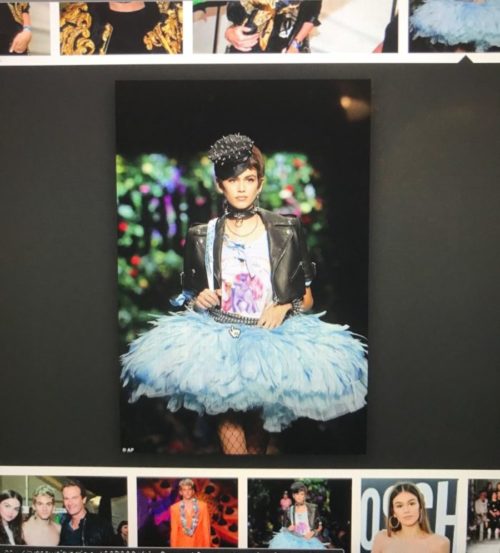How did Jeremy Scott capitalise on his ‘aura’ whilst simultaneously crowning himself the Founding Father of (21st century) Fast Fashion?

‘Some company recently was interested in buying my “aura”. They didn’t want my product. They kept saying, “We want your aura”. I never figured out what they wanted. But they were willing to pay a lot for it. So then I thought that if somebody was willing to pay that much for it, I should try to figure out what that is.’ -Andy Warhol
I am unsure as to whether Andy Warhol personally believed he was successful in ‘figuring out’ the marketability of his ‘aura’, but he most certainly triumphed in utilising its inherent mystique to cement his place within the Western art historical canon. If you see a Warholian work of art, the shadow of his authorship looms over its image: his soup cans, his saturated Marilyns, his acidic hibiscus flowerpieces—each undeniably drenched in the saccharine scent of his ‘Pop’ personhood. In the figure of Jeremy Scott, I am reminded of Warhol’s mass-appealing ‘aura’. However, in Scott’s case, his aura’s RRP is far more affordable, and by next season (or by the time his next collaboration drop hits), it will have metamorphosed to possess an entirely new face and/or aesthetic.

In the campaign artwork for his latest Moschino collection, in collaboration with H&M, Scott places himself front-and-centre. A large, gilded portrait bust of Scott eerily hangs in the backdrop, his icon securing his role as Creator of the collection, the luxury Italian fashion house he directs, and a generation of kitsch-kids who will queue for hours on end to invest in their own slice of 21st century pop-culture history. I was somewhat stunned by the intoxicating jolt of hysteria I experienced viewing this bust of Scott through the glass of H&M’s Regent Street flagship store on my walk to work. There were so many burning questions: Is he aggrandising the role of Designer? Is he mocking himself? Is the use of a sculptural relief with such strong classical connotations important? Why, oh why is it gold…

I am not shocked by Scott’s use of license in this play on portraiture: he has always heavily publicised the indoctrination of his self-image within Moschino’s branding. In conversation with Alice Casely-Hayford of British Vogue regarding the Moschino x H&M drop, Scott stated, ‘I started with the thought of how to make it the most Jeremy Scott for Moschino collection ever.’ I am not even shocked by the garishly bombastic representation of the self that lingers in this spectral, chain-ridden bust. Jeremy Scott has consistently inspired a playful subversion of the fashion industry’s grandiosity, with his Moschino collections of the past five years undoubtedly poking fun at the veil of exclusivity that shrouds the luxury goods market.

Franco Moschino himself similarly antagonised the culturally accepted signifiers of consumption through his irreverent humour and socially-conscious campaigns—which, likewise, featured himself.
I am, however, shocked by the forward motion of Scott’s cult of personality. A strong, creative character that functions as a personified embodiment of the luxury brand under their direction is not necessarily a negative, it is far less common that a fashion house is governed by an introvert. However, the Moschino brand now, in 2018, cannot be examined without the inclusion of Scott; his authorship is a function of Moschino’s further discourse, and consumers invest consciously into his strategically marketed, highly covetable ‘aura’.


Hot tip: type “HMMoschino” into the gif feature on your Instagram Stories for a hilarious insight into Mr Scott’s 21st Century aura. You’re welcome 😉
And I don’t know about the wider consensus but I’m looking forward to future @diet_prada content on Scott, coming soon to an iOS or android device near you.

References
A. Warhol, ‘THE Philosophy of Andy Warhol (From A to B and Back Again): 5. Fame (1975)’ in ON&BY ANDY WARHOL, ed. Gilda Williams, (Cambridge, Massachusetts, The MIT Press, 2016, p.53
Alice Casely-Hayford, ‘A First Look at the full Moschino x H&M Collection’, British Vogue, 25/10/2018. Online edition. https://www.vogue.co.uk/gallery/hm-announces-collaboration, accessed 15/11/2018




